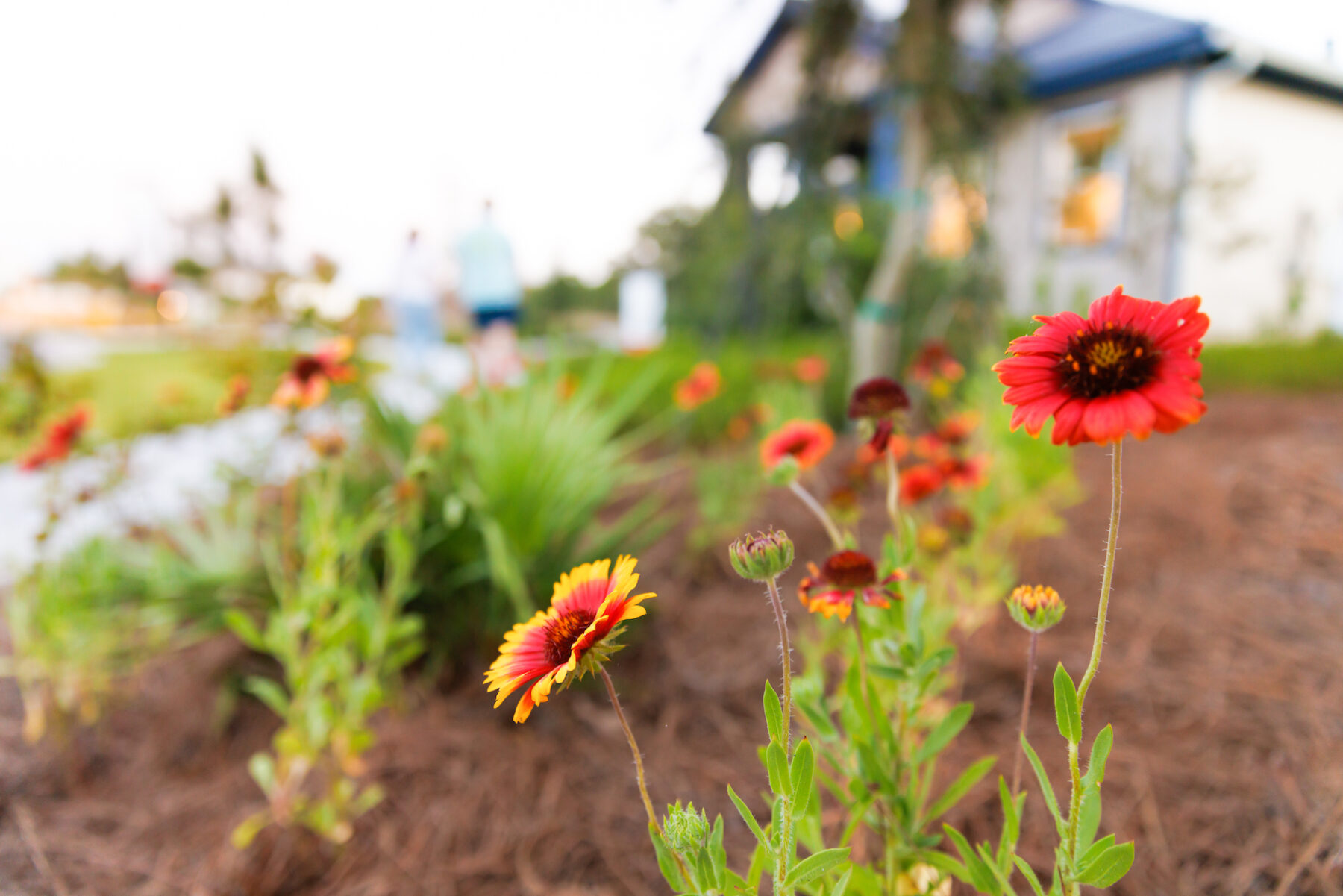 Find a Home in Weslyn Park
Find a Home in Weslyn Park

In the News: Reimagining new home construction with drought-free landscaping
UF/IFAS researchers have partnered with award-winning land developers in Central Florida to study the benefits of landscapes that move away from traditional turf lawns and instead incorporate drought-tolerant plants native to Florida. By studying two neighborhoods side-by-side, researchers can scientifically measure the benefits of more sustainable landscapes.
The project takes place in two residential neighborhoods, Weslyn Park and Del Webb Sunbridge, within Tavistock Development Company’s new master-planned community Sunbridge and joins partners from across the state. Scientists hope to quantify the costs and benefits of these unique landscapes and analyze impacts on water conservation, water quality, fertilizer, and pesticide reduction, wildlife benefits, and more. The research sites will provide data to validate shifting future communities toward a similar economic and environmentally responsible model.
At full buildout, Sunbridge will include more than 30,000 homes. The project is laying the groundwork in its first development phase with several research sites, including planting at Sunbridge’s welcome center, Basecamp, and various model home landscapes in the community’s newest neighborhood, Weslyn Park. The applied research project will compare the unique drought-tolerant and native-plant-focused designs with conventional landscapes just across the street in the community’s more established Del Webb Sunbridge neighborhood.
“We wouldn’t be able to do this if the developments were far apart,” said Basil Iannone, UF/IFAS urban ecology assistant professor. “Both communities are in similar environmental conditions, so we can make a side-by-side comparison that we’ve never done before. It allows us to learn much about how these two landscapes interact with the environment.”
This alternative landscape design is estimated to save 39,000 to 146,300 gallons of water per day through reduced irrigation and is estimated to reduce nitrogen use by 3,000 to 9,000 pounds per year. These numbers only include the first 300 homes and represent a significant reduction in chemical applications over current landscape practices.
These estimates are calculated using UF/IFAS irrigation and fertilization recommendations for common turfgrass yards and the average landscaped areas of the lots in the community.
“Water conservation and water-quality protection are foundational aspects of the commitment to sustainability in Sunbridge,” said Richard Levey, Chair of the Sunbridge Stewardship District. “Tavistock has partnered with UF/IFAS and the University of Central Florida scientists to create a living laboratory to test how sustainable landscape practices significantly reduce water for irrigation, improve the quality of stormwater runoff and enhance the ecology of Sunbridge. The findings of these studies could have far-reaching implications to improve land-development practices throughout the state.”
The advancement of environmental research and practices is part of a broader effort known as the Sunbridge Stewardship Plan. The plan includes partnerships with UF/IFAS Extension in Lake and Osceola counties, UCF, Cherrylake, LifeSoils, the Sunbridge Stewardship District, and The Nature Conservancy Florida Chapter to develop custom, data-driven programs that prioritize the natural world and native ecosystems in Sunbridge, which encompasses 27,000 acres across Orange and Osceola Counties.
In one of the first research projects in the neighborhood, scientists examine soil fertility by testing the benefits of adding compost to soils before planting and stretching the amount of time the plants can go without water.
“The soil condition is really poor after development. It’s like growing something on concrete,” said Iannone.
Preliminary findings show that a little compost can go a long way. The research is still preliminary but shows that plants in composted soil are healthier. This brings more than just curb appeal.
“A healthier plant means more flowers. More flowers mean more pollinators,” Iannone said. “If you improve soil and growing conditions, you have a healthier plant, attracting more wildlife. Treating our soil better helps plants establish better and provide more resources for wildlife more effectively. It makes total sense, but it is not something being done.”
In the future, scientists will learn more about the water-quality impacts of the different sites. They will test runoff from both conventional and modified landscapes and examine the nutrients present.
“The partnership between so many organizations coming together is what makes this research possible,” said Iannone. “We couldn’t do this without so many strong collaborators.”
The Sunbridge Stewardship Plan aims to protect the region’s natural ecosystem by improving five key areas: water quality preservation, water resource conservation, renewable energy and efficiency, ecological preservation, and community engagement. The research and standards being implemented in Sunbridge during these early development stages ensure the region’s natural environment is protected for future generations.
ABOUT UF/IFAS
The mission of the University of Florida Institute of Food and Agricultural Sciences (UF/IFAS) is to develop knowledge relevant to agricultural, human, and natural resources and to make that knowledge available to sustain and enhance the quality of human life. With more than a dozen research facilities, 67 county Extension offices, and award-winning students and faculty in the UF College of Agricultural and Life Sciences, UF/IFAS brings science-based solutions to the state’s agricultural and natural resources industries and all Florida residents. For more details, go to ifas.ufl.edu.
ABOUT SUNBRIDGE
Sunbridge is the latest community from the creators of Lake Nona, Tavistock Development Company. At the forefront of the region’s next wave of connective smart growth, the community encompasses more than 27,000 acres across both Orange and Osceola Counties in Central Florida between metro Orlando and the Space Coast. Built on the success of Lake Nona, Sunbridge carefully mixes residential, recreational, business, and civic uses designed to create connections to nature. Sunbridge is preserving large stretches of Florida nature and giving people unprecedented access to oak forests, lakes, wetlands, and waterways. The community opened in 2020. For more information, visit SunbridgeFl.com.
 Find a Home in Weslyn Park
Find a Home in Weslyn Park